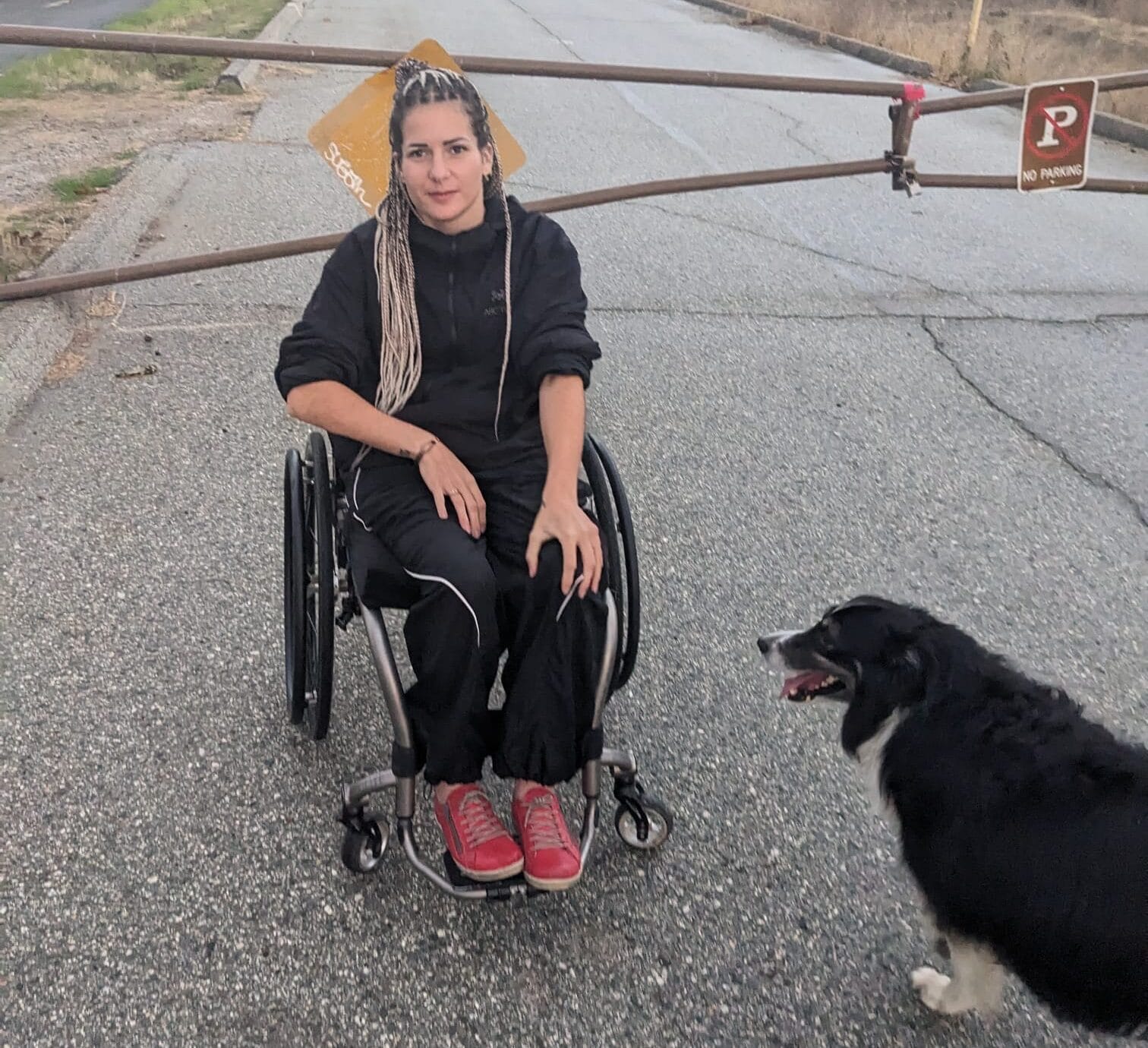Kelowna’s Dr. Paul Clark has enjoyed a long and rewarding career as an optometrist and has some excellent insight for people with SCI seeking to maximize their vision and eye health.
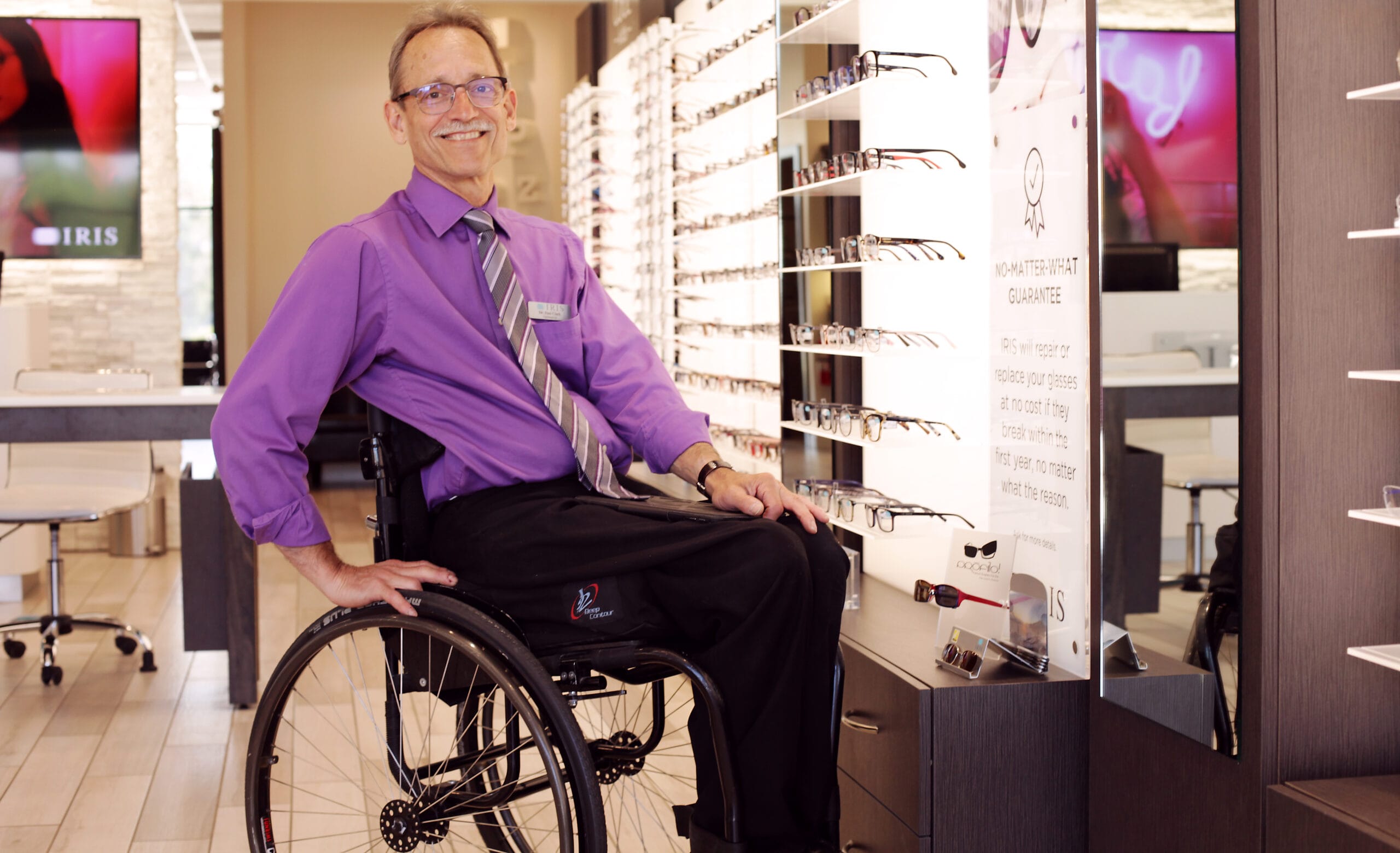
Back in 1973, if you told 15 year old Paul Clark he would embark on a career in optometry that would span four decades, he probably would’ve laughed at you. At the time, he was pretty sure he would end up working with his hands and a chest of tools, no doubt around his hometown of Woodstock, Ontario.
In the blink of an eye, a T5 complete SCI courtesy of a dirt bike accident had him reevaluating most aspects of his life, including his occupational aspirations.
“I had no idea what I could do for work so I decided to buckle down and study,” says Clark. “Amazingly, I found I was smarter than I thought, and increased my average. My options opened, and my experience as a nine-year-old getting glasses made me think of optometry—I could do it from a chair.”
Three years later, after graduating high school, Clark enrolled in first year science at the University of Waterloo. A year later, he was accepted into the university’s optometry program.
“I had to convince six professors I could do optometry from a chair, compared to the two profs other students would get for their interviews,” recalls Clark. “With a very positive attitude, I won them over and became the first optometrist in Canada to use a wheelchair.”
Throughout university, Clark juggled his studies with his increasing passion for wheelchair racing. In 1980, while competing at his first Paralympics in The Netherlands, he met a Dutch volunteer, Karin, who would eventually become his life partner. In 1981, he and Karin moved to Terrace, BC, his first stop as a newly-minted professional doctor of optometry.
“Our first son was born in 1989, after which we decided to live in Holland for four and half years to avoid the record snowfalls of Terrace,” recalls Clark. “Our second son and daughter were born in The Netherlands in 1992 and 1995 respectively. Then, in 1997, we moved to Kelowna.”
It was clearly a good move, as Clark and his family have called the Okanagan home ever since.
For the first 16 years of his career, Clark owned and operated his own independent clinic. In Kelowna, he first worked for several other clinics. Then, in 2003, he made the decision to join IRIS The Visual Group, a Canadian company founded by the late Dr. Francis Jean. Today, the company’s branded group represents the largest network of eye care professionals in Canada.
Clark’s Kelowna store and clinic, which he owns in partnership with the company, is one of 170 IRIS locations in Canada.
“Dr. Jean started IRIS The Visual Group with the intention of helping Canadians see better,” says Clark. “As a private optometrist, having juggled the clinical and sales sides, I was ready to spend more dedicated time with my patients. IRIS offered that opportunity, along with quality products that complete the experience of better vision I wish for all my patients.”
All in all, Clark says that optometry is a profession that is surprisingly accessible for people with SCI, providing they have full hand function.
“As a paraplegic optometrist, I have only modified my seating height with a specific wheelchair that has 26-inch wheels and sits seven inches higher than my regular chair,” he explains. “This allows me to be equal to the height of my seated patients with the ability to move the equipment, which swings from a standing unit. I use as much portable equipment as possible in order to eliminate body balance issues.”
While the majority of his clients aren’t wheelchair users, many SCI BC Peers and others with disabilities naturally gravitate to his practice. Not surprisingly, he strives to make his facility as wheelchair-accessible as possible.
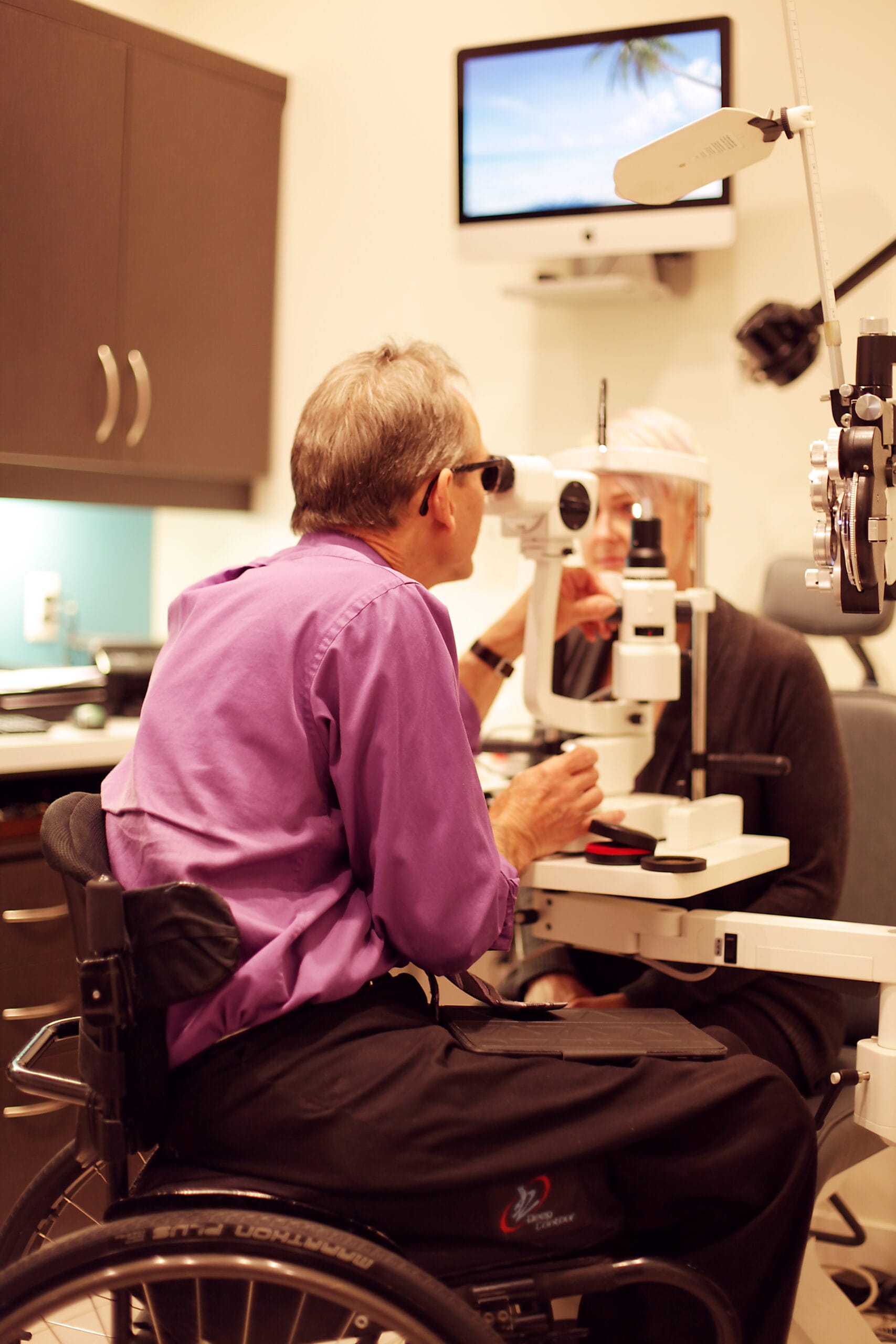
“I’m not specifically expecting others with SCI to choose my services, but they can be assured my space is accessible” he says. “I’ve designed my office to be wheelchair- friendly with an automatic door opener, plenty of room in the waiting area, a pre-test room with generous space, and, of course, a wheelchair-size washroom where chairs can turn around unobstructed.”
He also maintains it’s possible for him to examine almost everyone with an SCI, regardless of what level it is.
“Unfortunately, I’ve heard from some Peers that optometry offices have told them the eye exam wasn’t possible with them remaining in their chair. Certainly, the exam takes a bit longer, and there’s some creativity needed to get accurate results, but it’s far from impossible. My exam with patients who can’t transfer is modified with the use of hand-held lenses and other equipment.”
His advice for SCI BC Peers seeking an eye exam is full disclosure at the outset. “It’s best to tell the optometry office when you’re booking you use a wheelchair, and whether you can or can’t transfer,” he says. “Much like travelling by air, the better prepared the office is, the better experience you’ll have.”
Clark has always been interested in learning and observing how people with SCI can maximize their visual health. Here’s some of his accumulated knowledge:
- People with quadriplegia often experience some eyelid droop and have a smaller than average pupil size.
“Even in dimly lit situations, their pupils will fail to enlarge to a size that lets in a good amount of light,” he says. “This is a disadvantage for seeing things well in the dark, but may be considered an advantage when it comes to the need for glasses. Smaller pupils give a greater depth of focus, making them less sensitive to minimal refractive errors.”
Since many people with SCI use it to relieve pain and spasticity, we also asked Clark for his thoughts on cannabis, given that it’s used by some to relieve glaucoma, a potentially serious disease that results in high pressure in the eye.
“Cannabis has always been thought of as having a pressure-reducing effect in the eye, although few studies have been done until recently, and one has indicated the pressure rises,” he says. “What we do know is the effect of cannabis on eye pressure is much shorter-acting than drugs we currently have for glaucoma, so it’s a poor substitute.”
As for other medications, he cautions some prescriptions for spasms and anxiety can slow eye focus and make the eyes feel dry.
- Because many people with SCI spend a great deal of time in front of screens, either for work or recreation, extensive screen time can be of concern.
“With the increase in screen time, I’m hearing more complaints of discomfort and, importantly, poorer vision,” he says. “Perhaps because of mobility issues, many people with an SCI spend higher than average times on screens, especially small ones like smart phones, which have the highest concentration of blue light. Blue light contributes to focusing problems and even retinal damage over time. Often, my patients will blink to make things clear— the hallmark of dry eyes.” Consequently, he advises to limit screen time.
We also asked Clark for his advice on the best corrective strategies for people with SCI, taking into account the majority are usually sitting and not standing, and their hands are often occupied with mobility.
- He’s a fan of progressives—multi-focal lenses that give you up to three vision powers in one seamless package. You simply adjust your head position to see three ranges of distance—bring your head up to see far away; look straight ahead for mid-range vision, and point your nose down to read or text.
However, he cautions not everyone with SCI is a good candidate for progressives. “Due to mobility and dexterity issues, many SCI persons are unable to position themselves to best use progressive lenses in glasses,” he says.
He also cautions not all progressive lenses are equal. More expensive lenses are likely better designed than cheaper ones, and you should be given at least three options of good, better, best at your optical.”
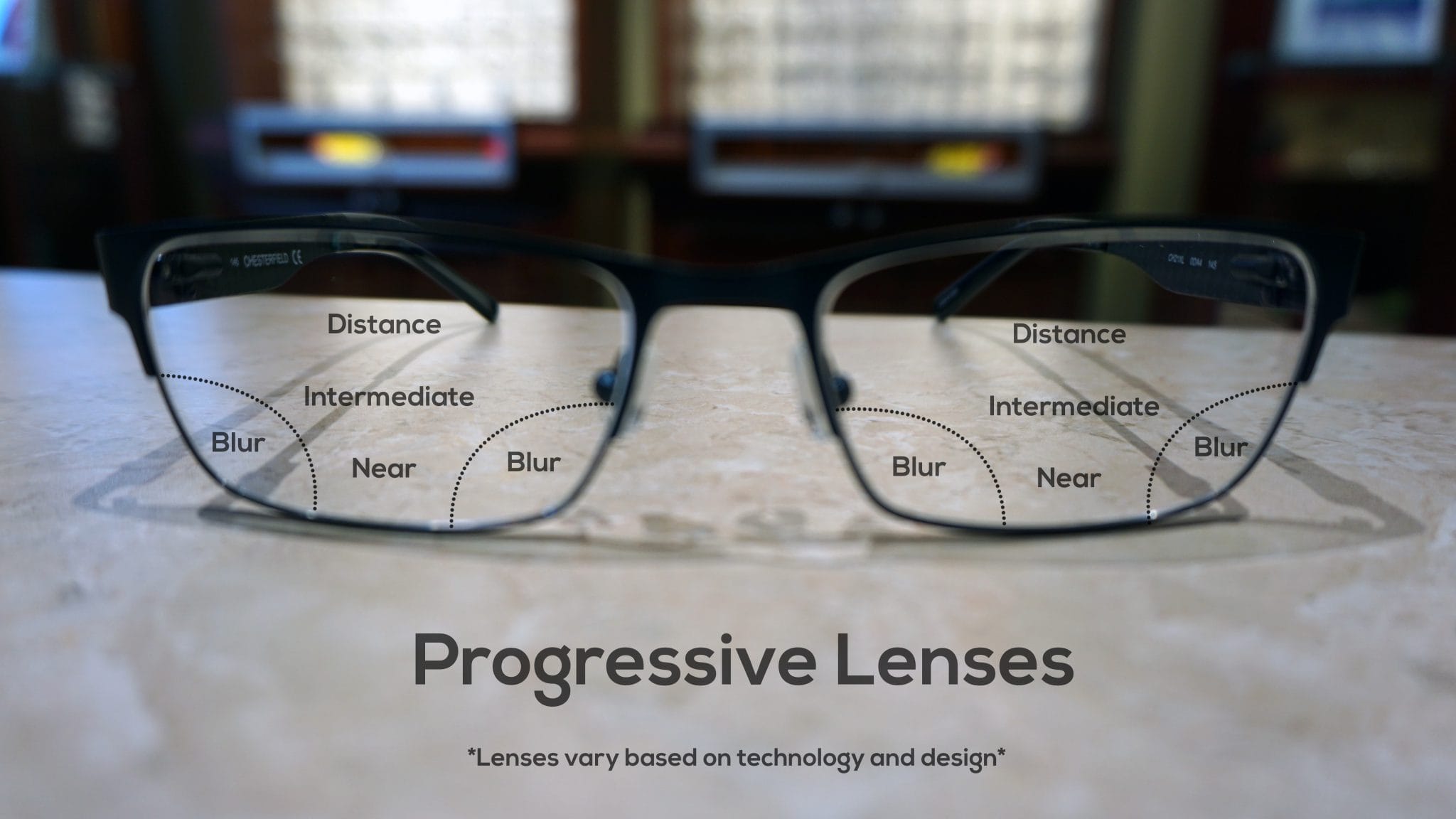
- What about contact lenses?
“With the advent of daily disposable contact lenses for everything from astigmatism to multifocal, they may now be an option,” he says. “Quads would have difficulty inserting and removing, but there are YouTube videos from those who were successful in their technique. Some optometrists feel comfortable letting patients wear specific types of lenses overnight, but this should only be done with caution since overnight wear is one of the leading reasons for loss of vision in young people. Some optometrists even offer the service of removing contact lenses and inserting a new set at the prescribed time.”
He adds that, unlike progressive glasses, multifocal contact lenses can’t correct astigmatism, so people who obtain success wearing contacts are those who wear glasses only for reading, or only for distance, not both.
- Another option is laser correction surgery. Typically, this procedure sees one eye corrected to provide good distance vision, and the other for reading distance.
“Some people with high level injuries may enjoy the freedom of laser vision correction just because their mobility issues hampers their ability to use progressive lenses and glasses,” he says, adding that high cost and the invasive and permanent nature of the procedure are sometimes deterrents.
- Sunlight protection. Quality sunglasses are a must, he says, with the ability to filter out 100 percent of ultraviolet light—the most harmful wavelength—being paramount. Adding polarization is also a good idea if you’re concerned about minimizing eyestrain.
“Wheelchair users may find photochromic lenses best because it eliminates the need to switch glasses when going outside,” says Clark. Photochromic lenses darken when exposed to ultraviolet light of sufficient intensity, and return to clear in darker settings.
For more information, or to contact Dr. Paul Clark, visit Iris.ca/kelowna or check out their Facebook page: iriskelowna.
This article first appeared in our Summer 2019 issue of The Spin and has been edited for our blog. Read the full version alongside other stories, including: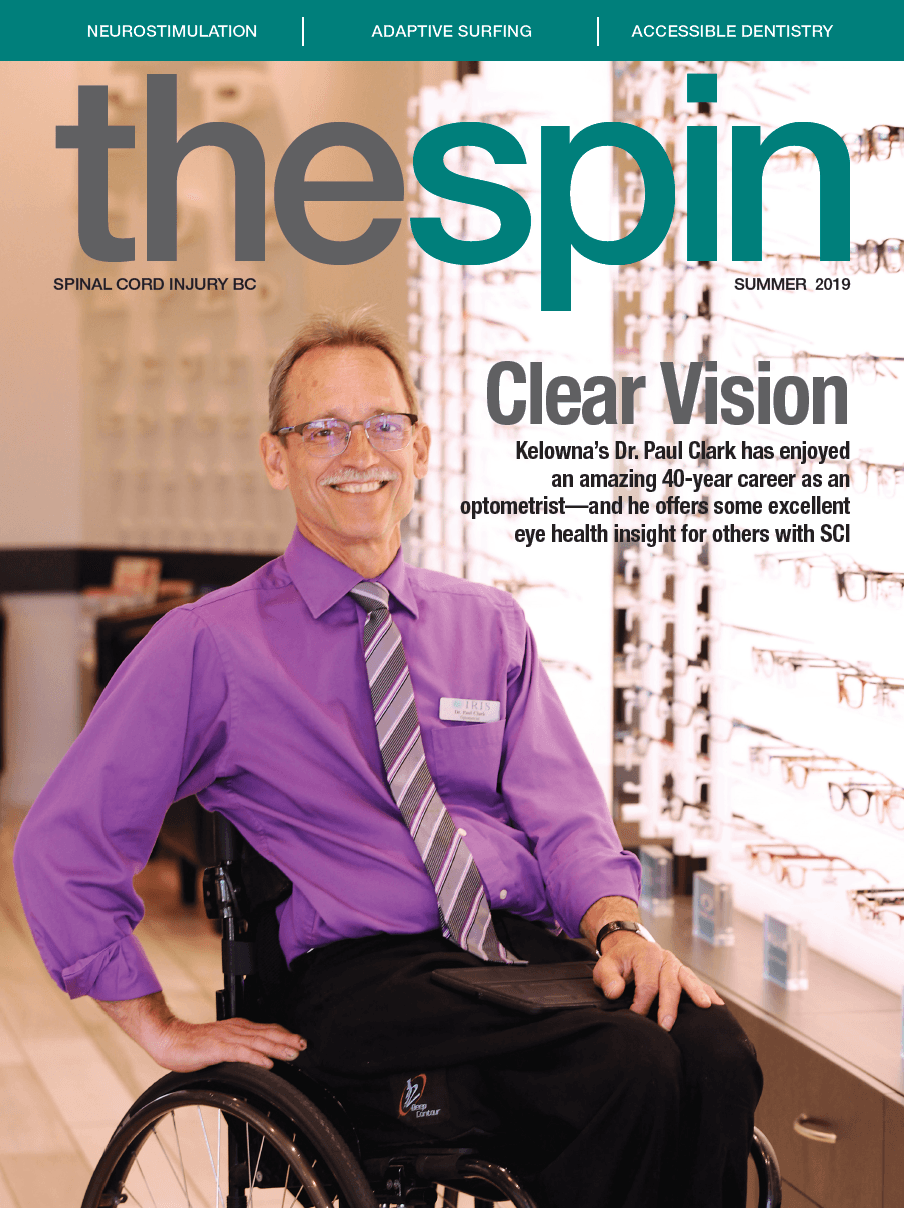
- Taking a Drive Down Memory Lane
- Reality Check: Neurostimulation Validity
- Adaptive Surfing
- and more!
